How to plant cucumbers for seedlings correctly, and when is it better to do it
Planting cucumbers in seedlings in spring allows you to bring the collection of the first fruits closer. And additional planting of cucumbers with seedlings in open ground in July will provide stocks of vegetables for pickles in autumn. Thus, growing healthy cucumber seedlings is the key to obtaining a stable harvest, sufficient both for fresh consumption and for harvesting. When to plant cucumbers for seedlings and how to do it right?
The content of the article
Determination of landing dates
The correct timing of planting is an important task for those who decided to start growing seedlings. If planted too early, the plants will stretch, outgrow and poorly transplant. If you tighten up with inoculation, the meaning of the procedure will disappear.

Depending on the climate of the region
The territory of Russia is very vast, and in each region the summer heat comes on time. For example, in the middle lane, return frosts are possible until the first days of June.
Need to know. Seedlings of cucumbers are planted in the ground 25-30 days after the emergence of sprouts.
The countdown point when landing in the ground is the date of the onset of stable heat... Thus, starting the countdown from the first days of June, sowing seeds for seedlings is carried out at the beginning of May.
Depending on the future landing site
If you are planning grow cucumbers in protected ground (greenhouse or greenhouse), seeds for seedlings can be sown earlier... On average, sowing dates in this case are shifted by two weeks. The specific date will depend on how quickly the soil in the shelter warms up and when the optimal microclimate for young plants is established there.
Depending on the variety
In regions with short and cool summers, the heat-loving cucumber is cultivated mainly in greenhouses.... In this case, it is recommended to plant parthenocarpic crop hybrids that produce fruits without pollination.
Such hybrids are ideal for growing in adverse climatic conditions. They begin to sow their seeds in early May.
The best time to plant according to the lunar calendar
Often, gardeners, when determining the sowing date, are guided by the lunar calendar. According to him, dates are considered auspicious days for planting cucumbers in 2020:
- in April - 5-7, 10-14, 18, 19, 23, 25-29;
- in May - 2-6, 15-17, 24-26.
However, you shouldn't be blindly guided by exact deadlines. It is smarter to use this information in combination with practical experience in growing cucumbers..
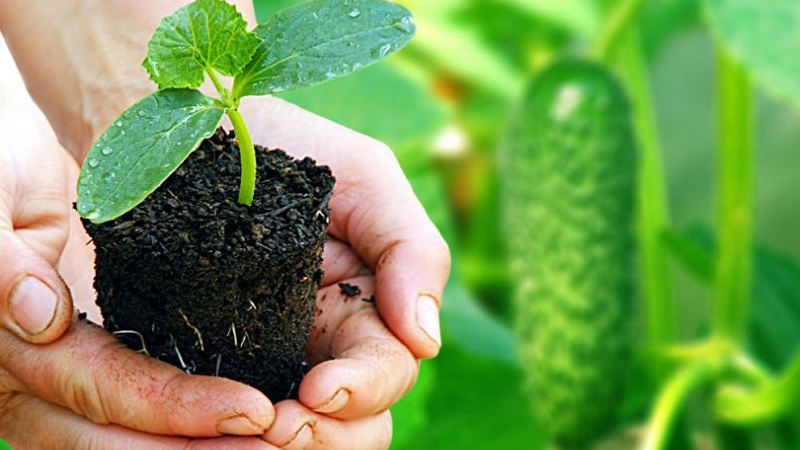
Moon phase influence
Sowing cucumber seeds begins immediately after the new moon or a few days before the full moon.
Attention! Roots develop better when the moon is in a waning phase, and the ground parts of the plant are actively formed when the moon is waxing.
When soaking seeds, the planting date is counted from the start of soaking, since when moisture gets inside the seed, the growth process immediately begins in it.
The influence of the moon sign
For plant growth influences not only the phase of the moon, but also the sign of the zodiac in which it resides... Vegetables that bear fruit above the ground, including cucumbers, are good to sow with the growing Moon in Cancer.
Seedling planting technology
How to properly plant cucumbers for seedlings? Planting technology consists of several stages: selection of seed, preparation of seeds, soil and containers and sowing directly. Let's consider each stage in more detail.
Seed selection
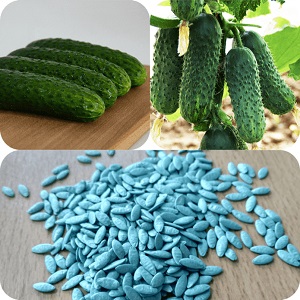 If you plan to plant cucumbers in protected ground, when choosing a variety, pay attention to the yield indicators and the ripening time of fruits... Parthenocarpic hybrids are well suited for planting in greenhouses and greenhouses. They produce fruits without insects participating in the pollination process.
If you plan to plant cucumbers in protected ground, when choosing a variety, pay attention to the yield indicators and the ripening time of fruits... Parthenocarpic hybrids are well suited for planting in greenhouses and greenhouses. They produce fruits without insects participating in the pollination process.
Seed material for open ground is selected especially carefully... Cucumber is a thermophilic plant, demanding on light and humidity. When choosing a variety, its zoning, the need for light and thermal conditions are taken into account. If the wrong variety is chosen, even with the observance of agricultural technology, the crop will not please.
Seed preparation for sowing, germination
In stores, more and more often they sell seed material already prepared for planting. Such seeds have already been calibrated, disinfected and treated with special compounds to accelerate growth. You don't need to do anything with them.
If the seeds are not prepared, it is necessary to carry out a number of procedures:
- Discarding empty seeds... The seeds are soaked in salted water and the floating ones are removed. They will either not grow, or the plants will be weak and sick. The remaining seeds are washed with running water and slightly dried.
- Disinfection... To destroy pathogenic microorganisms, seeds wrapped in cloth are placed in a 1% solution of potassium permanganate for 20-25 minutes. Then they are removed and washed with clean water. Instead of potassium permanganate, modern biological products are also used, such as "Alirin", "Fitosporin" or "Gamair". The etching solution is prepared according to the instructions. After disinfection with biological products, the seeds are not washed.
- Germination... To accelerate the emergence of seedlings, seeds are germinated by wrapping them in a damp cloth for several days. Wet sawdust is also used for germination.
Now the hatched seeds are ready for planting.
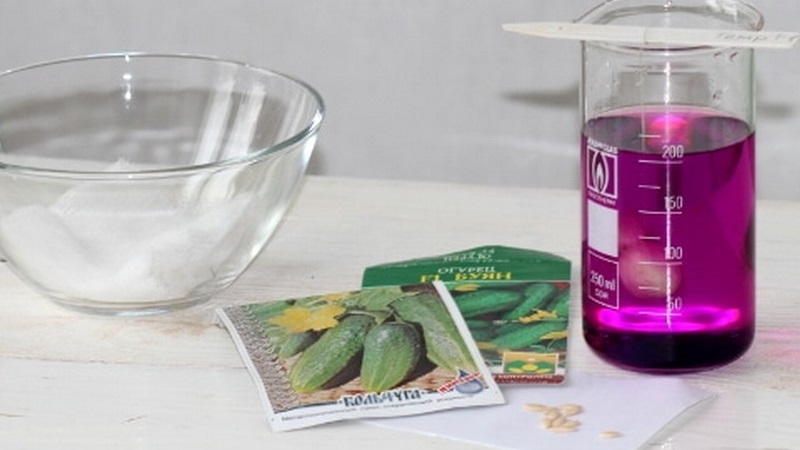
Soil and tank preparation
Cucumber seedlings need a lightweight, but moisture-intensive soil mixture... They buy it in a store or prepare it yourself.
Attention! If you sow cucumber seeds in prepared fertile soil, you will not have to feed the seedlings during growth.
The right seedling soil has four ingredients: leaf or sod land, compost, peat, river sand. All ingredients are mixed in a 1: 2: 1: 1 ratio.
Cucumber roots do not like to be disturbed by transplants, therefore it is preferable to use separate peat pots for sowing or food glasses.
Sowing
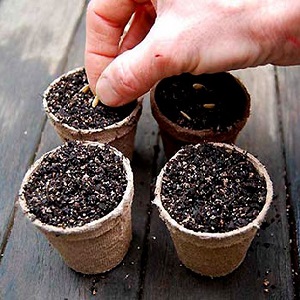 Prepared containers are filled with the mixture by two-thirds and well moistened... In the middle, a 1 cm depression is made and two seeds are placed in it. After germination, the strongest sprout is left. The second potted plant is removed by carefully cutting off the stem at ground level.
Prepared containers are filled with the mixture by two-thirds and well moistened... In the middle, a 1 cm depression is made and two seeds are placed in it. After germination, the strongest sprout is left. The second potted plant is removed by carefully cutting off the stem at ground level.
Special peat tablets are also suitable for cucumber seedlings... They are placed in plastic containers without a bottom, moistened with water and, after swelling, sown seeds. Ready seedlings are planted in the ground along with such a tablet.
After sowing, the containers are covered with foil and placed in a warm place.... The air temperature before germination is maintained at the level of + 25… + 28 ° С. Until the sprouts appear, the ground is not watered. If the soil dries up, it is moistened with a spray bottle.
It can be useful:
The best self-pollinated cucumber varieties for greenhouses
Early varieties of cucumbers for greenhouses and open field
The best varieties of shade-tolerant cucumbers for the greenhouse
Seedling care
Young green shoots appear in 4-5 days depending on seed preparation (dry or germinated) and their quality. After the emergence of seedlings, the film is removed, and the containers with the seedlings are transferred to a well-lit windowsill.
Light mode
Cucumber seedlings are demanding on lighting. Lack of sunlight is the main reason for pulling out the sprouts... In addition, when there is a lack of light, plants do not absorb nutrients well and begin to hurt. Therefore, for early sowing in March-April, additional lighting is used.
As the pots grow, they are pushed apart so that the leaves of neighboring bushes do not touch.
Temperature regime
For germination, cucumber seeds need a high temperature - not lower than + 25 ° С... But after the cotyledon leaves have opened, the temperature should be reduced to + 18 ... + 22 ° С and maintained at this level for the first 10-14 days.
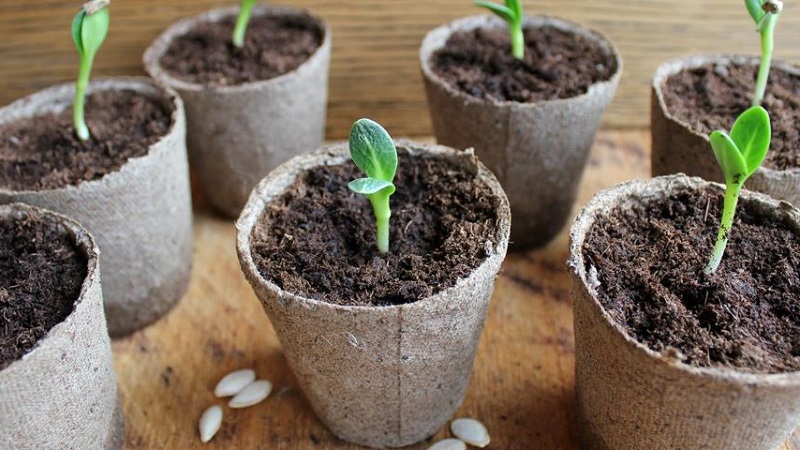
If it is not possible to regulate the air temperature in accordance with the above standards, it is enough to make sure that it does not rise above + 25 ° C during the day. At night, the air temperature should not fall below + 15 ° С, otherwise the seedlings will freeze.
Important! If the temperature regime is violated, the growth of seedlings slows down, the plants stretch out and begin to hurt.
14-15 days after the emergence of seedlings, the seedlings begin to accustom themselves to temperature changes in the daytime and at night. To do this, the room is regularly ventilated, avoiding drafts and a sharp drop in temperature.
Take an note:
Folk remedies for a better harvest of cucumbers
We save cucumbers from diseases and pests: important recommendations
Fertilization
If the soil mixture is prepared correctly, fertilizers are not applied during the growth of seedlings.
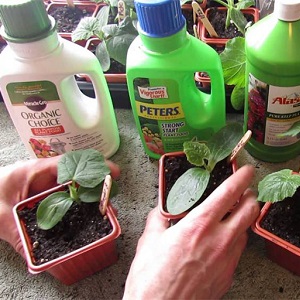 The growing period for cucumber seedlings is short, only 3-4 weeks, and the sprouts have enough nutrients in the soil.
The growing period for cucumber seedlings is short, only 3-4 weeks, and the sprouts have enough nutrients in the soil.
If poor soil was used for sowing, the sprouts will signal a lack of nutrition. Leaves are the first to react to a lack of trace elements - they change color, slow down growth, wither.
Cucumber seedlings are fed "Kemiroi", an ash solution, a mixture of trace elements with the obligatory presence of boron. Top dressing with microelements is carried out by spraying the leaves.
Council. Before feeding the seedlings, make sure that the problem is not caused by a violation of other conditions for growth and development: temperature, lighting, humidity and soil, diseases.
Before watering the seedlings with fertilizers, make sure the nutrient solution is weakly concentrated... The increased concentration of nutrients will destroy the tender sprouts. After top dressing, the ground is watered with clean water and mulched.
Irrigation mode
Watering is another important requirement for growing strong and healthy cucumber seedlings.
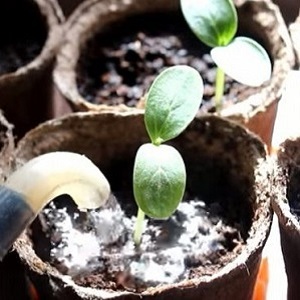 Watering the plants begins 5-7 days after the sprouts appear above the surface of the earth. To moisten the soil and spraying, use only warm (+ 24 ... + 25 ° C) settled water.
Watering the plants begins 5-7 days after the sprouts appear above the surface of the earth. To moisten the soil and spraying, use only warm (+ 24 ... + 25 ° C) settled water.
Up to this point, the soil is moistened only with a spray bottle.... If necessary, watering is carried out from above along the edge of the pot in a thin stream, without touching the leaves. It is also possible to irrigate through the pallet.
After each moistening, the surface of the earth is mulched with dry sand or a finely ground mixture of soil with humus.
Excess moisture leads to the growth of fungal microorganisms and decay of the root system. Fungal infections can quickly cause massive death of both young shoots and older seedlings.
Landing in the ground
Before planting seedlings in a permanent place, the plants are hardened. For this, containers with bushes are taken out onto a balcony or veranda. In this case, the residence time of plants in the fresh air is gradually increased. First, the pots are put out on the street for half an hour, then for an hour, etc.
Important! During hardening, do not leave seedlings in direct sunlight.
The day before landing in the ground seedlings are left outside overnight.
Seedlings are considered ready for planting 25-30 days after sowing.... On each bush at this time, as a rule, 3-5 developed leaves have already formed.
Plants are planted on prepared beds, after making holes at a distance of 30-40 cm from each other and watering them with water. When watering, it is good to add a solution of "Kornevin" or "Planriz" from rot and fertilizers, for example, "Athlete" or "Kemiru", to the pits.
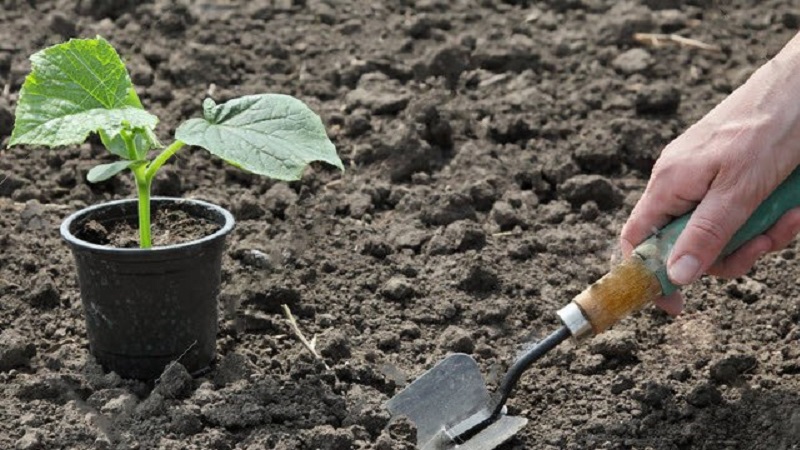
If the seedlings grew in a peat pot, it is placed in the hole so that the edge protrudes 0.5 cm above the soil surface. If in a plastic glass, the bush is carefully removed from the container along with an earthen lump, placed in the hole and sprinkled with earth.
After planting, the seedlings of cucumbers are watered warm water.
Timely disembarkation at a permanent location is very important. Overgrown plants take root more slowly and do not bloom as actively... And if the seedlings began to bloom before planting, the yield will inevitably decrease.
Conclusion
Not every summer resident, a special beginner, can grow an enviable harvest of cucumbers in his garden. One of the ways to increase yields is to plant cucumbers through seedlings.
When caring for seedlings, special attention is paid to ensuring the illumination of the crops, observing the temperature regime and watering. It is also important not to delay the transplanting of plants to a permanent place.